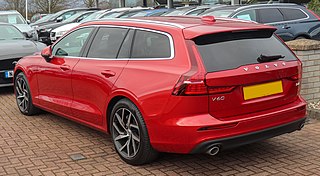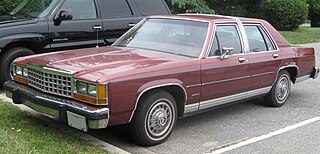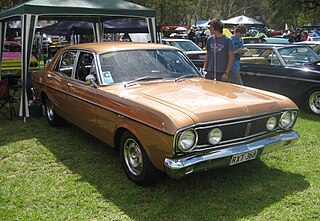Related Research Articles

A station wagon or estate car, is an automotive body-style variant of a sedan/saloon with its roof extended rearward over a shared passenger/cargo volume with access at the back via a third or fifth door, instead of a trunk/boot lid. The body style transforms a standard three-box design into a two-box design—to include an A, B, and C-pillar, as well as a D-pillar. Station wagons can flexibly reconfigure their interior volume via fold-down rear seats to prioritize either passenger or cargo volume.

The Ford Galaxie is a full-sized car that was built in the United States by Ford for model years 1959 through to 1974. The name was used for the top models in Ford's full-size range from 1958 until 1961, in a marketing attempt to appeal to the excitement surrounding the Space Race. In 1958, a concept car was introduced called "la Galaxie" which incorporated the headlights into pods inline with the grille and a reduced front profile.

The Ford Laser is a compact car, originally a subcompact car in the first three generations, which was sold by Ford in Asia, Oceania, and parts of South America and Africa. It has generally been available as a sedan or hatchback, although convertible, wagon and pick-up versions have also been available in different markets. The sedan, and briefly station wagon, versions were badged Ford Meteor in Australia between 1981 and 1987. The Ford Meteor name was also used in South Africa.

The Volkswagen Passat is a series of large family cars manufactured and marketed by the German automobile manufacturer Volkswagen since 1973, and now in its eighth generation. It has been marketed variously as the Dasher, Santana, Quantum, Magotan, Corsar and Carat. The successive generations of the Passat carry the Volkswagen internal designations B1, B2, etc.

The Ford Versailles was a mid-size automobile between 1991 and 1996 in Brazil and Argentina. It was a version of the Volkswagen Santana sold in the 1990s, when Ford and Volkswagen shared models in South America in a joint venture known as Autolatina. It replaced the Ford Del Rey in Brazil and the locally built Ford Sierra in Argentina. The station wagon version was sold as the Ford Royale.

The Volkswagen Santana is a nameplate used by Volkswagen for various sedans and station wagons since 1983. The first generation is based on the second-generation Volkswagen Passat (B2). It was introduced in 1981 while production started in 1983 for China. The use of the "Santana" badge rather than "Passat" echoes the use of different names for the sedan versions of the Polo (Derby) and Golf (Jetta).

The Ford LTD is a range of automobiles manufactured by Ford Motor Company for the 1965 to 1986 model years. Introduced as the highest trim level of the full-size Ford model range, then the Galaxie, the LTD offered options and features that had previously been reserved for more luxurious Lincoln and Mercury models. The largest vehicle produced by Ford in North America for most of its production, the LTD was joined by the intermediate Ford LTD II from 1977 to 1979; the LTD II served as the replacement for the Torino/Gran Torino range. At various times throughout its production, the LTD range included two- and four-door pillared and hardtop sedans, a two-door convertible, and the Country Squire five-door woodgrain station wagon.

A panel van, also known as a blind van, car-derived van or sedan delivery, is a small cargo vehicle with a passenger car chassis, typically with a single front bench seat and no side windows behind the B-pillar. Panel vans are smaller than panel trucks or cargo vans, both of which use body-on-frame truck chassis.

The Ford LTD Crown Victoria is a line of full-size cars that was manufactured and marketed by Ford from the 1980 to 1991 model years. Deriving its name from the Ford Fairlane coupe of 1955–1956, the LTD Crown Victoria served as the flagship of the Ford LTD model range in North America. Serving as the Ford counterpart of the Mercury Grand Marquis, the model line was offered as a two-door and a four-door sedan and a five-door station wagon.

The Ford Falcon is a model line of cars that was produced by Ford from the 1960 to 1970 model years. Though preceded by the Rambler American, the Falcon was the first compact car marketed by the Big Three American manufacturers.

The Datsun Cherry (チェリー), known later as the Nissan Cherry, was a series of subcompact cars which formed Nissan's first front-wheel drive supermini model line.

The Ford line of cars was again refreshed for 1952, although remaining similar to the all-new 1949 Fords. This time, curved one-piece windshield glass joined a new "Mileage Maker" straight-6 engine with 101 hp. The 226 CID (3.7 L) L-head straight-6 was replaced by an overhead valve 215 CID (3.5 L) Mileage Maker with 101 hp (75 kW), while the old 239 CID (3.9 L) Flathead V8 remained with 110 hp (82 kW). This design would continue through the 1954 model year, with an updated design offered in 1955.

The 1955 Ford is an automobile which was produced by Ford in the United States for the 1955 model year and, in revised form, for the 1956 model year. A new design would be offered in 1957.

The Ford Falcon (XL) is a mid-size car which was produced by Ford Australia from 1962 to 1964. It was the second iteration of the first generation of the Falcon

The Ford Falcon (XW) is a full-size car that was produced by Ford Australia from 1969 to 1970. It was the third iteration of the second generation of the Falcon and also included the Ford Futura (XW) and the Ford Fairmont (XW)—the luxury-oriented version.

The Ford Falcon (XD) is a full-size car that was produced by Ford Australia from 1979 to 1982. It was the first iteration of the fourth generation of the Falcon and also included the Ford Fairmont (XD)—the luxury-oriented version.

The North American version of the Ford Granada is a range of sedans that was manufactured and marketed by Ford over two generations (1975–1982). Developed as the original successor for the Ford Maverick, the Granada shares its name with Ford of Europe's flagship sedan. The model line was marketed as a luxury compact vehicle, expanding the segment in the United States.

The Ford Falcon (XT) is a full-size car that was produced by Ford Australia from 1968 to 1969. It was the second iteration of the second generation of the Falcon and also included the Ford Fairmont (XT)—the luxury-oriented version.

The Volkswagen Passat (B2) is an automobile which was produced by German manufacturer Volkswagen from 1981 to 1988. It was the second generation of the Volkswagen Passat. The platform was slightly longer than the preceding Passat (B1). As with the previous generation, it was based on the platform of the Audi 80; the corresponding B2 version of which had been already launched in 1978. The Santana was also manufactured in China, Brazil, Mexico and Argentina. In Brazil, the Santana station wagon was sold as the Quantum. In the United States, both the Santana sedan and station wagon were sold as the Quantum. The Passat saloon and estate were produced in South Africa for their local market until 1987. The production of Passat B2 in China ended in January 2013.

The third-generation Volkswagen Passat, known as Volkswagen Passat B3 or Volkswagen Passat 35i, was introduced in March 1988 in Europe, 1989 in North America, and 1995 in South America; it was also briefly available in Australia in 1991, when a total of 14 Passat GL 16V in sedan and wagon versions were sold by then importer TKM. Unlike the previous two generations of the Passat, the B3 was not available as a fastback - only 4-door sedan and 5-door station wagon versions were available, setting the precedent for the model for all subsequent generations to date. Its curvy looks were a contrast from the boxy appearance of its predecessor and owed much to the "jelly mould" style pioneered by Ford with the Sierra and Taurus. The lack of a grille, utilizing the bottom breather approach, made the car's front end styling reminiscent of older, rear-engined Volkswagens such as the 411, and also doubled as a modern styling trend. The styling was developed from the 1981 aerodynamic Auto 2000 concept car.
References
- 1 2 VW Passat Variant, www.netcarshow.com Retrieved 24 June 2015.
- 1 2 Ford Royale 1992 (sales brochure), storm.oldcarmanualproject.com Retrieved 23 June 2015
- ↑ Ford Royale 1995 (sales brochure), storm.oldcarmanualproject.com Retrieved 23 June 2015